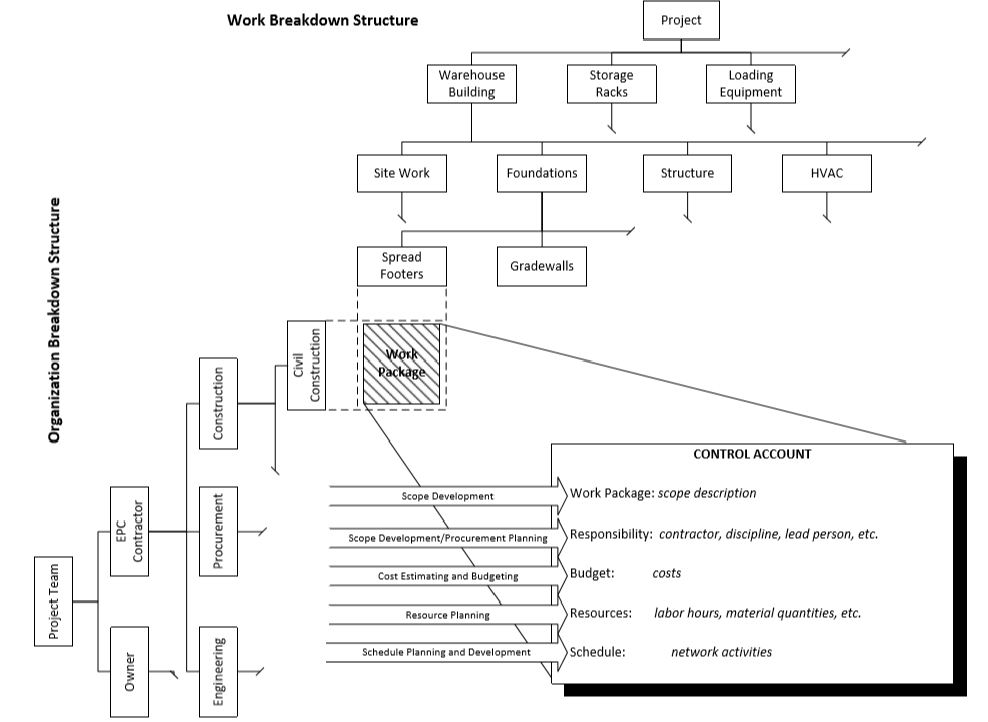All work packages are linked a Control Account, which acts as a management control point (budget for the work package)
In project management, a control account is a management control point where scope, budget, actual cost, and schedule are integrated and compared to the project management plan. It serves as a key element in the Work Breakdown Structure (WBS) hierarchy, representing a major deliverable or a group of related deliverables.

Here are the key aspects of a control account:
- Integration of Scope, Budget, and Schedule: A control account encompasses a set of work packages or tasks that are related in terms of scope, budget, and schedule. It provides a focal point for monitoring and controlling project performance.
- Cost Control: Control accounts are used to monitor and control project costs. They provide a basis for comparing actual costs with budgeted costs, allowing project managers to identify variances and take corrective actions as necessary.
- Schedule Control: Control accounts also play a role in schedule management. They help track progress against the project schedule, ensuring that work is being completed as planned and identifying any schedule deviations that need to be addressed.
- Performance Measurement: Control accounts serve as a basis for measuring project performance. By comparing actual progress and costs to planned values at the control account level, project managers can assess overall project performance and make informed decisions.
- Responsibility Assignment: Each control account is typically assigned to a specific individual or team responsible for its execution. This ensures accountability for the associated work and facilitates effective management of project resources.
Overall, control accounts provide project managers with a structured approach to monitoring and controlling project performance, helping to ensure that projects are completed on time, within budget, and according to scope. They serve as an essential tool for project management in complex endeavors.
Control accounts examples
Let’s delve into examples of control accounts in both Engineering, Procurement, and Construction (EPC) projects and Information Technology (IT) projects:
- EPC Project: Construction of a BridgeControl Account Example: Bridge Construction
- Integration of Scope, Budget, and Schedule: The control account for bridge construction encompasses all activities related to building the bridge, including foundation work, structural assembly, and finishing.
- Cost Control: The control account tracks expenses such as materials, labor, equipment rental, and subcontractor costs associated with bridge construction. Any discrepancies between planned and actual costs are identified and addressed.
- Schedule Control: Progress against the planned schedule for bridge construction is monitored at the control account level. Delays or deviations from the schedule are analyzed, and corrective actions are taken to mitigate impacts on project timelines.
- Performance Measurement: Performance metrics such as earned value are calculated for the bridge construction control account, providing insights into cost and schedule performance relative to the project baseline.
- Responsibility Assignment: The construction manager is typically responsible for overseeing the bridge construction control account, ensuring that all tasks are executed according to plan and coordinating with subcontractors and other stakeholders as needed.
- IT Project: Development of a Mobile ApplicationControl Account Example: Mobile App Development
- Integration of Scope, Budget, and Schedule: The control account for mobile app development encompasses activities such as requirements gathering, design, coding, testing, and deployment.
- Cost Control: Costs associated with mobile app development, including software licenses, developer salaries, testing tools, and hosting fees, are monitored within the control account. Budget deviations are analyzed, and corrective actions are taken as necessary.
- Schedule Control: Progress against the planned schedule for mobile app development is tracked at the control account level. Any delays or bottlenecks in the development process are identified and addressed promptly to keep the project on track.
- Performance Measurement: Key performance indicators such as user stories completed, features implemented, and bugs fixed are used to measure progress within the mobile app development control account.
- Responsibility Assignment: The project manager or development team lead is typically responsible for overseeing the mobile app development control account, ensuring that all tasks are assigned and completed according to schedule and quality standards.
In both examples, the control accounts serve as focal points for monitoring and controlling project performance, integrating scope, budget, and schedule considerations. They facilitate effective management and decision-making, ensuring that projects are completed successfully and in line with stakeholders’ expectations.
